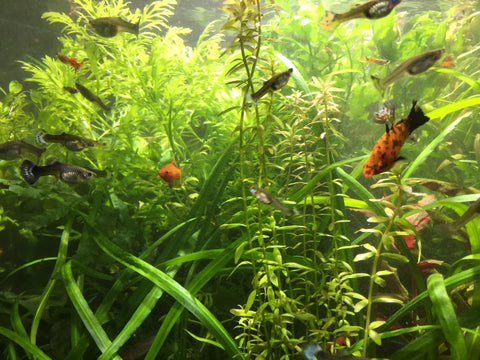- Continue Shopping
- Your Cart is Empty
Re-imagining the "community tank"- Or, you CAN go home again.
Remember back when you got your first aquarium? If you're like most hobbyists, it was a modest-sized aquarium, set up as a "community tank."

I LOVE community tanks! And I LOVE the idea that, even as so-called "advanced" hobbyists, there is something irresistible to us about creating a tank with a variety of cool fishes in it, isn't there?

Right? The term "community tank" is descriptive- albeit a bit quaint. It describes a group of different fishes living together in the same tank in relative harmony. The concept has been the backbone of the aquarium hobby for generations. Community tanks have introduced thousands of people to the wonders of the aquarium hobby.

To the more advanced hobbyist, the community tank holds a different allure; it's a fun way to showcase a bunch of different species that might otherwise not be found together. Ahh, that's the key- "species which might otherwise not be found together." A cool concept, although not particularly "natural" for the fishes from an environmental standpoint. Oh sure, I know the argument can easily be made that simply having fishes living in a glass or acrylic box is not "natural", but that's not the point here.
Have you noticed that, as we evolve as hobbyists, we seem to rationalize that a "real" community tank would be far more interesting, educational, and successful- if it actually contained fishes from the same region, environmental niche, etc.? So, we create "specialiized" community tanks. For example, Rift Lake cichlids, Tetras, Rainbowfshes, etc. We just can't seem to shake the allure of seeing several species living together in the same tank in relative harmony.
And we always seem to "specialize" a bit, right? Yet, even the hobbyists with the 30-50 tank fish room dedicated to say, cichlids or catfishes, always seems to have one or two tanks with a few different species thrown together. It's like it's in our blood. We just can't shake the idea of the community tank. Nor should we.

For some reason, this type of setup is seen as "basic", yet it's just as compelling for more sophisticated hobbyists. And that's what's so col about the hobby. We never seem to lose that "wonder"- that sense of pleasure of seeing a bunch of our favorite fishes all living together- despite how specialized our interests may be.

I remember the fishes of my childhood: The Danios, the Mollies, Flame Tetras, etc. They held- they hold- and allure that goes beyond simple nostalgic yearnings- they piqued my curiosity to learn more about the natural environments from which they come.

Nowadays, I still keep Flame Tetras. However, they are in an aquarium which bares far more resemblance to their natural environment than I ever maintained them in before- and they are far nicer, healthier, and happier than the ones I've maintained in the past. Not a week goes by when hobbyists, seeing pics of my tank on social media, ask me what fishes they are...ann each time, they're like, "Really? Flame Tetras? I used to have those when I was a kid..."
Even the most "bread and butter" fishes seem to do better, look better, breed more readily- when we keep them in conditions similar to their natural environment. This is not a secret, nor is it some mystery concept. We all know this. And that's what's kind of cool. We can still play with the same fishes we had when we were a kid, yet in a more sophisticated manner, and still derive endless enjoyment from them.
Love it.

Ridiculously simple, yet easily overlooked takeaway from today? If you don't already, try keeping some of those fishes from your childhood again. Keep 'em in a community tank if you want- but one that is more similar to their natural environment. See the differences. Enjoy the experience.

Never stop.
Stay enthralled. Stay engaged. Stay filled with wonder.
And Stay Wet.
Scott Fellman
Tannin Aquatics









Scott Fellman
Author